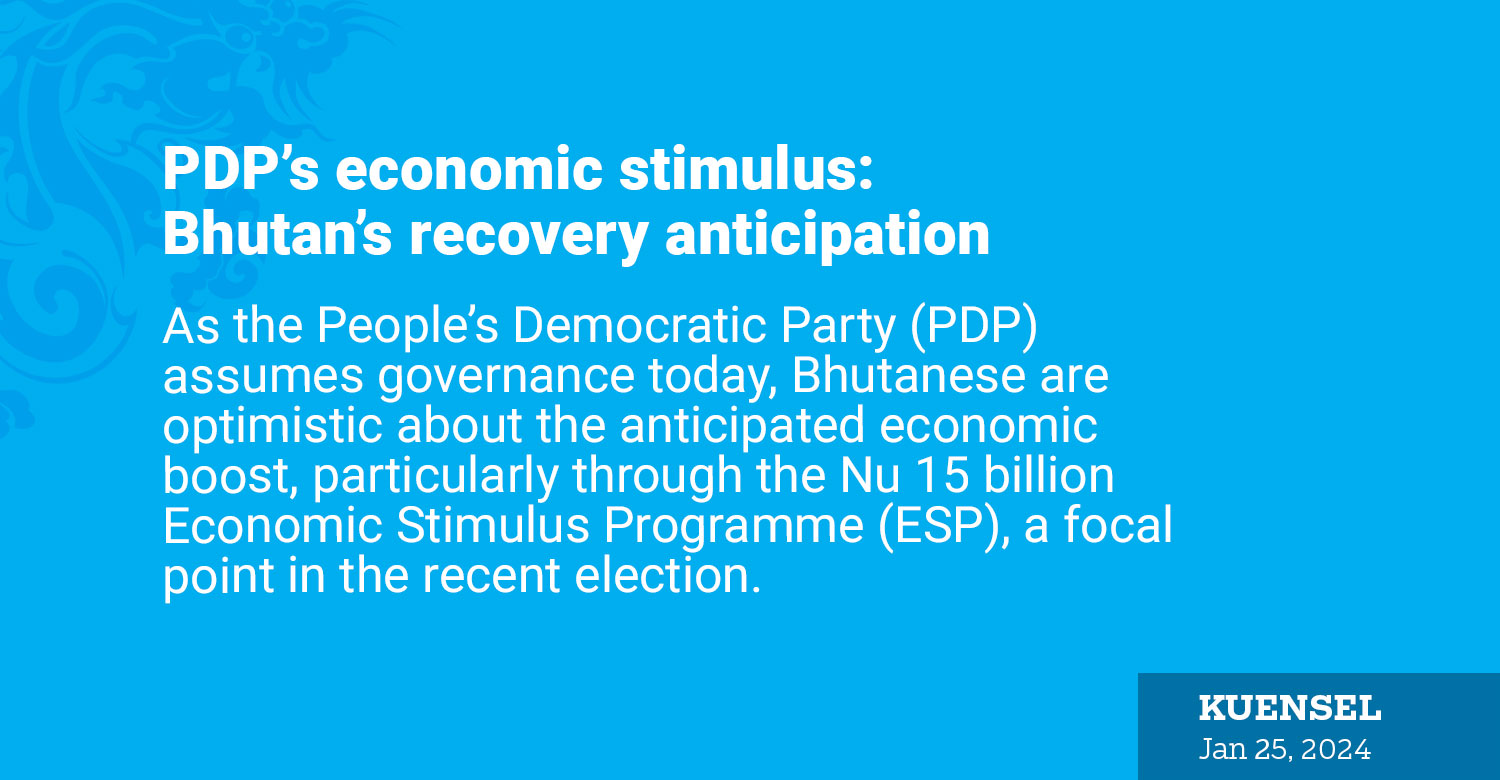Thukten Zangpo
As the People’s Democratic Party (PDP) assumes governance today, Bhutanese are optimistic about the anticipated economic boost, particularly through the Nu 15 billion Economic Stimulus Programme (ESP), a focal point in the recent election.
Despite the country’s economic growth forecasted to slow down to 3.9 percent in 2023 and 4.7 percent in 2024 from 5.2 percent in 2022, attributed mainly to a decline in construction activity, the PDP’s ESP is expected to play a pivotal role.
Economists and bankers express varied opinions on the ESP, emphasising investment in sectors like agriculture, manufacturing, and tourism. The government intends to fund the programme out of the 13th Plan budget outlay of Nu 512 billion, with assistance from the Government of India.
Optimal allocation of the ESP, according to experts, should target quality employment generation and labour productivity particularly through capital deepening. Capital deepening is a situation where the capital per worker is increasing in the economy, also referred to as increase in the capital intensity.
Suggestions include focusing on agriculture, manufacturing, and output subsidy support in agriculture. An economist added that the focus should be on the agriculture and manufacturing sector (household and small manufacturers), especially value addition on agricultural and livestock products and artisan production.
“In agriculture, the focus should shift from input subsidy to output subsidy supported by market-based instruments such as insurance schemes and price hedging,” he added. “To boost aggregate demand, the government should also focus from supply side tourism policy to demand side tourism policy.”
The PDP government pledged to form a high-powered task force to develop the implementation of the 15 billion ESP with the establishment of economic development chaired by the prime minister.
The pledges included injecting liquidity in the banking sector, enabling loan deferments, reducing interest rates, and creating other loan schemes to boost the economy.
There are also plans to set up a special loan scheme to support special groups like farmers, women, youth, persons with disabilities and special investments for economic growth of rural areas and creation of specialised credit windows dedicated for the cottage and small industries.
Another economist said that prior to injecting liquidity in the economy, the government should focus on building a conducive environment for businesses and investments (domestic and foreign direct investments), including the involvement of the private sectors.
He added that there is also a requirement of re-engineering in the public servants to create a conducive environment for economic activities especially the highly regulated licensing system.
Investing in domestic agriculture production would be a must as Bhutan is an import-dependent country with the situation of borrowed inflation felt by the people, an economist said. “A government or private sector should come up with distribution centers or networks for agricultural products.”
He added that the government should also look into reforming the state-owned enterprises which are crowding-out the private sector and leverage on the start of the public-private partnerships model.
On the other hand, the bankers are worried about their liquidity position. A banker said that the country’s current economic situation is not good and banks’ liquidity position is just above the margin.
“Some portion of the ESP has to be pumped into banks as a seed fund or deposits to revamp the economy since banks are facing the liquidity crunch because of loan deferment and no repayment,” he said. For example, a bank used to receive Nu 250 to Nu 300 million per month from the repayment.
A banker added that the banks have only usual deposits like savings and from salary earners and not much deposits from the business community which is not substantial to plough back in the economy as loans. “We are facing difficulty to meet the liquidity requirements.”
According to the RMA report 2023, the banking sector’s liquidity stood at Nu 13.83 billion in June last year, a decline by 43.5 percent compared to the same month of the previous year at Nu 24.48 billion.
The liquidity in banks has been decreasing steadily over the years because of decline in inflow of foreign exchange and increasing demand for meeting short-term foreign exchange payment obligations and rising financing needs for government expenditure.
“If the government continues loan deferment and reduces the housing loan interest rates to 4 percent as pledged by the government, a banker said that the deficit in the liquidity in the banks will continue. This would compromise the Royal Monetary Authority’s projected credit growth of 21.2 percent in the fiscal year 2023-24.
He added that the priority sector to inject the portion of the ESP would be in the agriculture sector, manufacturing and industry, and in the tourism sector like construction of hotels. “The financial sector is awaiting the government’s detailed plans on where and how they will invest.”
On the other hand, the Bhutan Chamber of Commerce and Industry’s president, Tandy Wangchuk, said that the post-pandemic economy is not doing well, making it difficult for businesses to keep up with loan repayments. He asked for the deferment in foreclosure of the loans.
“Businesses appeal to give them some breathing room for about 5-6 months before taking serious action that will allow them to recover financially and eventually repay their loans,” Tandy Wangchuk said.
Private sector also waits for the government to walk-in and unleash their ESP to boost the economy.
Under monetary measures IV announced in June 2022, high-risk sectors such as hotels, restaurants, tourism, and airlines received a two-year loan deferment until 2024, while moderate and low-risk sectors got a deferral until June 2024 after the decision of the RMA’s 200th board meeting held in May last year.
Agriculture-related services, trade, education, and health services are classified as low-risk.
The moderate sectors include construction (contract-based), hospitality, entertainment, recreational services, mining and quarrying, manufacturing enterprises, handicrafts and textile production, retail trade, commercial housing, home loans, personal loans (consumer and mortgage), transportation (commercial and non-commercial), and education loans.


